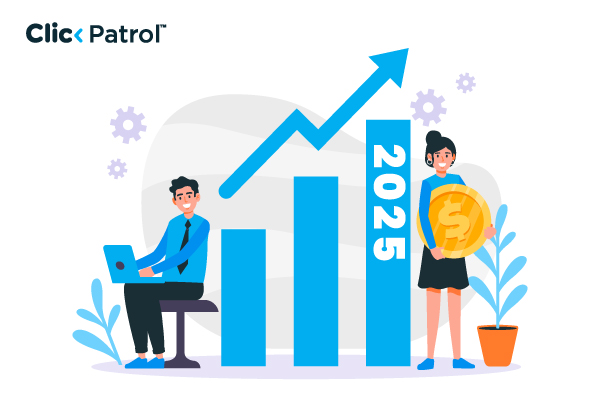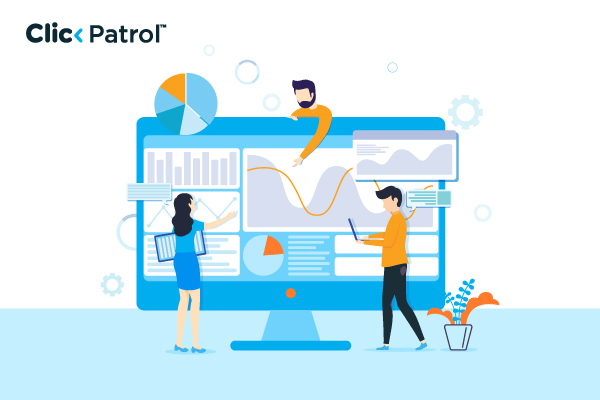
Bot farms explained: How they operate and how to protect your business from fake traffic
Abisola Tanzako | Jun 26, 2025

Table of Contents
- What are bot farms?
- How bot farms operate: Infrastructure and behavior
- Top tools for detecting and blocking bot farm traffic
- Bot farms in digital marketing: Why marketers should care
- Real-life impact of bot farms on digital marketing
- How to detect bot activity
- Combating bot farms: What marketers can do
- The future of bot farms: AI and automation
- The ethical dimension: Why it matters beyond marketing
- The battle for authenticity in digital marketing
- FAQs
Bot traffic makes up over 42% of global internet traffic, with bot farms responsible for a significant share.
In a universe where online interactions, social media platforms, and web-based campaigns dominate, much of what we see, hear, and believe on the net is manipulated by unseen forces. Among the strongest and least appreciated are bot farms.
These vast networks of bots warp web structures, bias information, and sway everything from politics to web marketing campaigns.
A 2023 Business of Apps study estimates that bots generate 22% of total web traffic worldwide, and bot-driven ad fraud in advertisements costs advertisers approximately $84 billion annually.
This article explains how bot farms work, the risks they pose to advertisers, and how to defend against them.
What are bot farms?
A bot farm is a company with many automated accounts, “bots,” programmed to perform actions imitating actual humans. These actions can vary from liking posts, following accounts, commenting, and sharing content to clicking on ads.
As opposed to legitimate automation or customer service bots, bot farms are employed with the aim of deception: to simulate, mislead, and overstate artificial activity.
They can scale from hundreds to millions of accounts, typically controlled from central systems or even real devices (e.g., click farms).
How bot farms operate: Infrastructure and behavior
Bot farms use both software and hardware solutions in maintaining and expanding their activities:
- Automation scripts: Bots are designed to mimic human actions such as commenting, liking, and following within an interval and frequency that would make them imperceptible.
- Proxy servers and VPNs hide the bots’ IP addresses, geographically spreading their activity.
- AI-generated content: High-tech farms use AI to write naturally appearing comments or postings that outsmart simple spam filters.
- Physical click farms consist of many smartphones or computers in a single location, controlled by human operators or mechanical systems to produce engaging content.
Top tools for detecting and blocking bot farm traffic
Here are the top tools for detecting and blocking bot farm traffic, widely used by businesses to protect their websites and digital platforms:
1. Imperva bot protection
- Strengths: Advanced bot detection using behavioral analysis and machine learning.
- Features: Real-time mitigation, device fingerprinting, threat intelligence.
- Best for: Enterprises needing strong protection against sophisticated bots and bot farms.
2. Cloudflare bot management
- Strengths: Built into Cloudflare’s CDN and firewall services.
- Features: Bot score system, machine learning models, JS challenges.
- Best for: Businesses already using Cloudflare for performance and security.
3. DataDome
- Strengths: Real-time bot protection with low latency.
- Features: Mobile SDKs, CAPTCHA, threat dashboards.
- Best for: E-commerce, travel, and ticketing platforms vulnerable to bot abuse.
4. Akamai bot manager
- Strengths: Deep traffic analysis and reputation-based detection.
- Features: Granular control, real-time bot categorization, analytics.
- Best for: Large websites and apps facing high bot traffic volumes.
5. PerimeterX (now HUMAN)
- Strengths: Strong focus on preventing fraud and abuse by bots.
- Features: Behavioral fingerprinting, threat intelligence, customizable responses.
- Best for: Retailers, media companies, and SaaS platforms needing bot defense.
Bot farms in digital marketing: Why marketers should care
They include:
1. Ad fraud and waste of budget
One of the most brazen financial impacts of bot farms is ad fraud. Bots click on ads to blow through advertising budgets without driving real consumer demand. According to the Business of Apps report 2023, global advertisers lost an estimated $84 billion to ad fraud in 2023.
2. Influencer marketing deception
Influencer marketing relies on trust and credibility. However, several influencers have been found to purchase bot farms’ artificial followers and engagement to boost their perceived influence.
59.8% of brands reported influencer fraud during campaign runs, a 2023 Firework study stated.
Platforms like TikTok took down 32.6 million artificial followers during the first quarter of 2024.
3. SEO and content manipulation
Bot farms can generate artificial site traffic and backlinks, which spam search engine rankings. This undermines the integrity and relevance of search results, making it harder for original content creators to compete.
Real-life impact of bot farms on digital marketing
One of the most perceptive cases of bot farm manipulation in digital marketing was revealed in 2018, when The New York Times looked for an American company called Devumi.
The company sold millions of fake social media followers, likes, and retweets, produced mainly by bot farms. Influencers, celebrities, and even politicians were among their customers, all wanting to artificially inflate their online standing.
For advertisers, the consequences were enormous. Influencers spent millions with brands that appeared popular but had fake account followings, resulting in low ROI and lost confidence in influencer marketing.
Consequently, platforms like Twitter purged over 70 million fake accounts, and advertisers began requesting stricter performance expectations and follower audits.
This instance is a wake-up call to marketers to prioritize authenticity most carefully, screen partnerships, and use detection technologies to safeguard campaigns against non-human traffic.
How to detect bot activity
Even when bot farms become increasingly sophisticated, there are still some telltale signs that marketers and users of the platforms can watch out for:
- Unnatural behavior: Bots will comment, like, or post at unrealistic levels, sometimes every few seconds or minutes.
- Duplicate messages: Various accounts generally have identical or almost identical text, hashtags, or links, usually supporting one agenda or another.
- Generic accounts: Most bot accounts lack profile pictures and descriptions or show AI-created pictures that are too clean and appear man-made.
- Low comment-to-post ratio: Accounts may have many followers but very few real comments and interactions, which is a sign of fake engagement.
- Synchronized activity: Spam groups of accounts act in coordination, so they like or retweet the same posting simultaneously to influence platform algorithms.
Combating bot farms: What marketers can do
They include:
- Apply advanced bot detection solutions: Many ad platforms and analytics solutions currently utilize AI-based bot detection. Marketers should adopt these solutions into their procedures to eliminate non-human traffic and interaction.
- Carefully audit influencer collaborations: Use proprietary software to confirm the authenticity of influencer followers and engagement. Verify discrepancies between follower counts and actual levels of engagement with others.
- Monitor traffic and engagement patterns: Sudden traffic spikes, low conversion rates with many visits, or unusual geographic bunching can indicate bot activity.
- Educate marketing teams and clients: Growing awareness of bot farm threats encourages recognition of why some metrics are unreliable and encourages transparency.
- Encourage platform responsibility: Support policies like the EU’s Digital Services Act, which requires transparency and takes action against inauthentic platform behavior.
The future of bot farms: AI and automation
The advent of generative AI adds another level of sophistication. Bots are now able to:
- Make undetectable human-sounding natural language posts.
- Make deepfake profile photos and even videos.
- Engage in real-time conversation and persuasion.
The ethical dimension: Why it matters beyond marketing
Bot farms waste advertising budgets and invalidate public trust in the online world and the validity of online interactions. It has spillover effects in society:
- Consumers become deceived and lose trust in brands.
- Platforms become vulnerable to reputational as well as regulatory risks.
The battle for authenticity in digital marketing
Bot farms are not just a technological headache; they are a systemic threat to the integrity of digital advertising. Their influence is far-reaching and corrosively deep, ranging from distorting campaign metrics to draining ad budgets to misleading consumers.
As artificial intelligence increasingly empowers such networks, it is becoming increasingly complex to distinguish actual human behavior from computer-generated deceit.
For marketers, this is not a technology problem but a trust problem. Credibility is the foundation on which all great marketing lies. When followers are for sale, metrics can be bought, and trends can be faked, everybody, from consumers to brands, loses.
But within this challenge is an opportunity. Marketers can build more credible, human, and performance-driven campaigns by actively indicating bot traffic, auditing influencer partnerships, investing in AI-fueled fraud prevention technologies, and educating clients and teams.
Protect your brand from phony engagement. Start your free traffic with ClickPatrol today and take back control of your marketing ROI.
FAQs
Q. 1 What is a bot farm?
A bot farm is an organized undertaking employing many automated accounts to simulate real human online behavior. Its purpose is to force manipulative metrics, spread disinformation, or continue fraud.
Q. 2 How do I know if an influencer’s followers are real?
Seek quality engagement: Are there authentic comments? Do followers display diversity of action and location?
Q. 3 Are all bot activities harmful?
No, some engage in customer service automation, news feeds, or access tasks. Bot farms are a technical term used for fraudulent or manipulative purposes.
Q. 4 How can marketers protect their ad budget from bots?
They use fraud detection tools, engage platforms like ClickPatrol, measure traffic quality, and choose good ad networks and influencers as key strategies.





